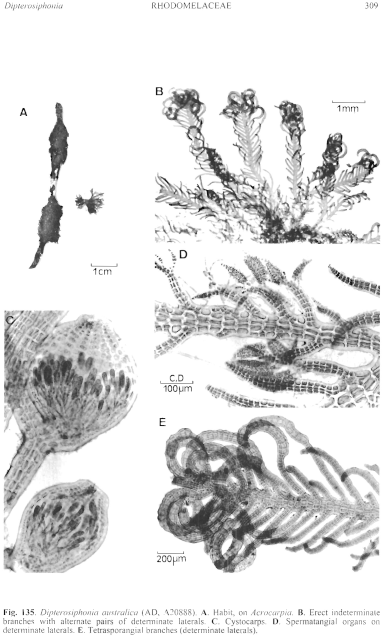|
|
|
|
|
|||||||||||
|
Electronic Flora of South Australia Species Fact Sheet
Phylum Rhodophyta – Family Rhodomelaceae – Tribe Herposiphonieae
Thallus (Fig. 135A) dark brown-red, densely clothing the host for 1–3 cm, 3–5 mm high (thick) with compressed prostrate axes producing alternate pairs of determinate laterals, the anterior often becoming indeterminate, free and more or less erect (Fig. 135B), 2–7 mm long, with anterior and posterior determinate laterals terete and mostly simple. Attachment by rhizoids; epiphytic, mainly on the axes of Acrocarpia paniculata. Structure. Apical cells hemispherical, 15–20 µm in diameter, segmenting transversely and obliquely in the pattern of the genus, with the anterior determinate lateral branched and the posterior simple, the anterior frequently becoming indeterminate with determinate laterals 400–800 µm long, mostly simple and 35–70 µm in diameter, segments L/D 0.2–0.4. Axes and determinate laterals with usually 6 pericentral cells, axes 90–140 µm broad, segments L/D 0.4–0.8. Trichoblasts occasional, on determinate laterals, branched, 400–800 µm long, basal cells 15–20 µm in diameter and L/D 1–1.5, slenderer above. Rhizoids cut off from axial pericentral cells, unicellular with multicellular haptera. Cells uninucleate; rhodoplasts discoid to elongate.
Reproduction: Gametophytes dioecious. Procarps not observed. Carposporophytes with a small basal fusion cell and branched gonimoblast with clavate terminal carposporangia 20–30 µm in diameter. Cystocarps (Fig. 135C) lateral on determinate laterals, subsessile, ovoid to very slightly urceolate, 300–400 µm in diameter; pericarp ostiolate, 2 cells thick, ecorticate, outer cells angular, isodiametric. Spermatangial organs (Fig. 135D) replacing trichoblasts, lanceoid, 80–140 µm long and 35–55 µm in diameter, with a single basal and 2–3 apical sterile cells.
Tetrasporangia in determinate laterals (Fig. 135E), the ends curved to recurved and 400–1000 µm long; fertile segments 60–90 µm in diameter, tetrasporangia in a curved line, 35–65 µm in diameter with 2–3 cover cells.
Type from Stanley beach, S coast Kangaroo I., S. Aust., on Acrocarpia paniculata, drift (Womersley, 2.ii.1957); holotype in AD, A20888.
Selected specimens: Vivonne Bay, Kangaroo I., S. Aust., on Myriodesma harveyanum (Womersley, 1.i.1996; AD, A13039). Pennington Bay, Kangaroo I., S. Aust., reef edge (Kraft 4323, 4.iv.1972; AD, A42452). Stanley Beach, Kangaroo I., S. Aust., on Acrocarpa, drift (Womersley, 7.ii.1956; AD, A20094). Point Lonsdale, Vic., on tunicate, 2.5–4 m deep (Kraft, 1.iii.1989; MELU). San Remo, Vic., on Laurencia, drift (Sinkora A2009, 22.xi.1974; AD, A19568; MEL, 2010984).
Distribution: South coast of Kangaroo I., S. Aust. to San Remo, Victoria. Probably more widely distributed than the few records.
Taxonomic notes: D. australica is distinguished by the similarity of the simple anterior and posterior determinate laterals and the largely free nature of the indeterminate branches; it appears to be epiphytic on larger brown algae and not Amphibolis. The specific name is based on its Australian distribution.
References: The Marine Benthic Flora of Southern Australia Part IIID
Publication:
Womersley, H.B.S. (24 February, 2003)
The Marine Benthic Flora of Southern Australia
Rhodophyta. Part IIID. Ceramiales – Delesseriaceae, Sarcomeniaceae, Rhodomelaceae
Reproduced with permission from The Marine Benthic Flora of Southern Australia Part IIID 2003, by H.B.S. Womersley. Australian Biological Resources Study, Canberra. Copyright Commonwealth of Australia.
Illustration in Womersley Part IIIA, 2003: FIG. 135.

Figure 135 enlarge
Fig. 135. Dipterosiphonia australica (AD, A20888). A. Habit, on Acrocarpia. B. Erect indeterminate branches with alternate pairs of determinate laterals. C. Cystocarps. D. Spermatangial organs on determinate laterals. E. Tetrasporangial branches (determinate laterals).

|
Email Contact: State Herbarium of South Australia |

|